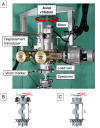Comparison between different methods for biomechanical assessment of ex vivo fracture callus stiffness in small animal bone healing studies
- PMID: 25781027
- PMCID: PMC4363594
- DOI: 10.1371/journal.pone.0119603
Comparison between different methods for biomechanical assessment of ex vivo fracture callus stiffness in small animal bone healing studies
Abstract
For ex vivo measurements of fracture callus stiffness in small animals, different test methods, such as torsion or bending tests, are established. Each method provides advantages and disadvantages, and it is still debated which of those is most sensitive to experimental conditions (i.e. specimen alignment, directional dependency, asymmetric behavior). The aim of this study was to experimentally compare six different testing methods regarding their robustness against experimental errors. Therefore, standardized specimens were created by selective laser sintering (SLS), mimicking size, directional behavior, and embedding variations of respective rat long bone specimens. For the latter, five different geometries were created which show shifted or tilted specimen alignments. The mechanical tests included three-point bending, four-point bending, cantilever bending, axial compression, constrained torsion, and unconstrained torsion. All three different bending tests showed the same principal behavior. They were highly dependent on the rotational direction of the maximum fracture callus expansion relative to the loading direction (creating experimental errors of more than 60%), however small angular deviations (<15°) were negligible. Differences in the experimental results between the bending tests originate in their respective location of maximal bending moment induction. Compared to four-point bending, three-point bending is easier to apply on small rat and mouse bones under realistic testing conditions and yields robust measurements, provided low variation of the callus shape among the tested specimens. Axial compressive testing was highly sensitive to embedding variations, and therefore cannot be recommended. Although it is experimentally difficult to realize, unconstrained torsion testing was found to be the most robust method, since it was independent of both rotational alignment and embedding uncertainties. Constrained torsional testing showed small errors (up to 16.8%, compared to corresponding alignment under unconstrained torsion) due to a parallel offset between the specimens' axis of gravity and the torsional axis of rotation.
Conflict of interest statement
Figures






Similar articles
-
Biomechanical evaluation of healing in a non-critical defect in a large animal model of osteoporosis.J Orthop Res. 2003 Sep;21(5):836-42. doi: 10.1016/S0736-0266(02)00266-8. J Orthop Res. 2003. PMID: 12919871
-
Prediction of the time course of callus stiffness as a function of mechanical parameters in experimental rat fracture healing studies--a numerical study.PLoS One. 2014 Dec 22;9(12):e115695. doi: 10.1371/journal.pone.0115695. eCollection 2014. PLoS One. 2014. PMID: 25532060 Free PMC article.
-
Intact fibula improves fracture healing in a rat tibia osteotomy model.J Orthop Res. 2005 Mar;23(2):489-93. doi: 10.1016/j.orthres.2004.08.007. J Orthop Res. 2005. PMID: 15734267
-
Prediction of fracture callus mechanical properties using micro-CT images and voxel-based finite element analysis.Bone. 2005 Mar;36(3):480-8. doi: 10.1016/j.bone.2004.11.007. Bone. 2005. PMID: 15777656
-
Biomechanical and biological aspects of defect treatment in fractures using helical plates.Acta Chir Orthop Traumatol Cech. 2014;81(4):267-71. Acta Chir Orthop Traumatol Cech. 2014. PMID: 25137496 Review.
Cited by
-
Percutaneous-Reinforced Osteoplasty: A Review of Emerging Treatment Strategies for Bone Interventions.J Clin Med. 2022 Sep 22;11(19):5572. doi: 10.3390/jcm11195572. J Clin Med. 2022. PMID: 36233434 Free PMC article. Review.
-
A preclinical large-animal model for the assessment of critical-size load-bearing bone defect reconstruction.Nat Protoc. 2020 Mar;15(3):877-924. doi: 10.1038/s41596-019-0271-2. Epub 2020 Feb 14. Nat Protoc. 2020. PMID: 32060491
-
Age Dependence of Systemic Bone Loss and Recovery Following Femur Fracture in Mice.J Bone Miner Res. 2019 Jan;34(1):157-170. doi: 10.1002/jbmr.3579. Epub 2018 Sep 24. J Bone Miner Res. 2019. PMID: 30189111 Free PMC article.
-
Estrogen Receptor α Signaling in Osteoblasts is Required for Mechanotransduction in Bone Fracture Healing.Front Bioeng Biotechnol. 2021 Dec 7;9:782355. doi: 10.3389/fbioe.2021.782355. eCollection 2021. Front Bioeng Biotechnol. 2021. PMID: 34950644 Free PMC article.
-
Transient peak-strain matching partially recovers the age-impaired mechanoadaptive cortical bone response.Sci Rep. 2018 Apr 27;8(1):6636. doi: 10.1038/s41598-018-25084-6. Sci Rep. 2018. PMID: 29703931 Free PMC article.
References
-
- Engesaeter LB, Ekeland A, Langeland N. Methods for Testing the Mechanical Properties of the Rat Femur. Acta Orthop. 1978; 49: 512–518. - PubMed
-
- Ekeland A, Engesaeter LB, Langeland N. Mechanical properties of fractured and intact rat femora evaluated by bending, torsional and tensile tests. Acta Orthop Scand. 1981; 52: 605–613. - PubMed
-
- Keller TS, Spengler DM, Carter DR. Geometric, elastic, and structural properties of maturing rat femora. J Orthop Res. 1986; 4: 57–67. - PubMed
Publication types
MeSH terms
LinkOut - more resources
Full Text Sources
Other Literature Sources

